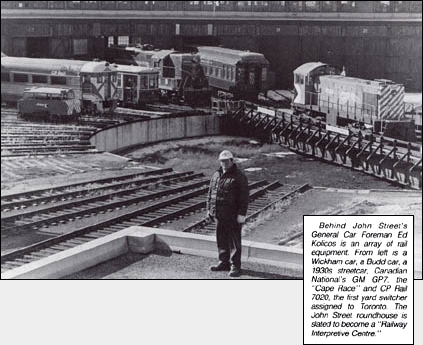Vol. 17 No. 4
April, 1987
|
Stay Safe in 87
|
|
"John Street Polish" Roundhouse's
Trademark
By Jim Barlow
 Toronto Ontario - On a warm, muggy day last August a group of
employees gathered in front of the John Street Roundhouse for a photograph.
Toronto Ontario - On a warm, muggy day last August a group of
employees gathered in front of the John Street Roundhouse for a photograph.
The quiet occasion, in reality, was a wake for a 57-year-old building that had once been the last word
in railway technology and an enormous source of pride to CP Rail and those who worked within and around its walls.
From October, 1929, through the golden age of steam during the 1930's, 1940's, and 1950's, the John Street Yard
built a reputation that earned it a place in Canadian railway lore.
Its 32 bays were the maintenance centre for the likes of the "Chicago Express", the "Overseas",
the "Royal York", the "Dominion", and the "Canadian", all famous names during the
height of Canadian Pacific's rail passenger service days.
Steam locomotives of the Toronto, Hamilton & Buffalo Railway and the New York Central were familiar sights inside
the walls. The roundhouse was truly the company's heart of steam activity.
PRIDE
During the steam era, locomotives serviced at John Street were readily recognized.
After the nitty-gritty of mechanical overhaul and adjustment, it was not unusual to have as many as six
men wipe down the engine after washing. Junior crew members attended to the shine of the lower part of the engines
while the seniors buffed a high shine to the top. This roundhouse trademark became know as the "John Street
polish".
The facility was the first and largest direct steaming type operation in Canada. In this system the firebox was
emptied outside, the locomotive driven into the roundhouse on the remaining steam, hooked up to a steam main system
until serviced, then given a boost of operating pressure through the system and rolled out to a
firing-up house.
The use of direct steam from a central plant, provided by the Toronto Terminal Railway Company, improved working
conditions and reduced fuel consumption.
FEATURES COPIED
In fact, many of the design features and concepts used in building the roundhouse have only recently been adopted by
modern architects. In his "Short History" of the roundhouse, John Street Yard carman Randy Marsh
writes: "Its employment of an integrated energy system, as well as other conservation-minded
production methods, allowed it to form a total engineering system, an integrated, fully-functional
steam locomotive terminal.
At the end of the 1940's, the CPR stood tall with an impressive complement of steam locomotives and one of the
continent's premiere maintenance facilities.
For those who looked closely, however, the writing was on the wall. As far back as 1937 the railway had recognized
the potential of diesel power. In that year a road switcher, numbered 7000, entered service in Montreal.
In early 1960, steam locomotives 2839 and 1271, the last of the breed, made their final trips from John Street. The
brute strength of steam gave way at the roundhouse to the servicing of RDC's, regular passenger trains such as the
"Canadian" and road switcher units. The heydays at the roundhouse, for all intents and purposes, were over.
Considering its history, it's not surprising there are plans for the facility. City of Toronto planners envisage a
"Railway Interpretive Centre". Surrounded by a parkland promenade, they see the roundhouse as a museum to
house equipment and pieces from Canada's railway past. Adjacent would be a rotunda which would be a showcase for new
rail technology.
The turntable, which in years past bore the weight of countless hissing steam locomotives, would be the centerpiece
of equipment, gift boutiques, and food outlets. CP Rail has endorsed the plan and turned over the facility to the
city in 1985.
Left at the roundhouse are four examples of another era - ironically two are from the early dieselization period.
Canadian National's GM GP7, a 1950's giant painted in the period company colours of olive green and yellow; a 1930's
streetcar that once plied the streets of Toronto; the "Cape Race", one of 13 buffet lounge, double bedroom
steel cars built for the CPR about 1929; and another diesel, CP Rail 7020, the first yard switcher assigned to
Toronto are at the roundhouse.
They sit in the eerie silence of the cavernous interior. Despite the years of wear and tear, the tracks bordering the
bays are still shiny and the floor, gouged here and there by shifted heavy equipment years ago, are clean.
The over-all impression is that of a temporary lull in activity and that somehow, any moment, one of
those snarling, steam-breathing giants will roll into place and be readied for a John Street
polish.
This CP Rail News article is copyright
1987 by the Canadian Pacific Railway and is reprinted here with their
permission. All photographs, logos, and trademarks are the property of the Canadian Pacific Railway
Company.
|